Home » FAQ
This post focuses on a like-for-like comparison of power generation  costs. Consider a classic PR announcement that PQR Renewable Energy is intending to spend £1 billion on an offshore wind farm that will supply 500,000 households with electricity and will create 200 permanent jobs (the example and numbers are fictitious). Does this mean what it says? Two points will illustrate why it does not. The cost will normally exclude the cost of providing the lines required to transmit the power that is generated from the wind farm to wherever it is used.
costs. Consider a classic PR announcement that PQR Renewable Energy is intending to spend £1 billion on an offshore wind farm that will supply 500,000 households with electricity and will create 200 permanent jobs (the example and numbers are fictitious). Does this mean what it says? Two points will illustrate why it does not. The cost will normally exclude the cost of providing the lines required to transmit the power that is generated from the wind farm to wherever it is used.
 costs. Consider a classic PR announcement that PQR Renewable Energy is intending to spend £1 billion on an offshore wind farm that will supply 500,000 households with electricity and will create 200 permanent jobs (the example and numbers are fictitious). Does this mean what it says? Two points will illustrate why it does not. The cost will normally exclude the cost of providing the lines required to transmit the power that is generated from the wind farm to wherever it is used.
costs. Consider a classic PR announcement that PQR Renewable Energy is intending to spend £1 billion on an offshore wind farm that will supply 500,000 households with electricity and will create 200 permanent jobs (the example and numbers are fictitious). Does this mean what it says? Two points will illustrate why it does not. The cost will normally exclude the cost of providing the lines required to transmit the power that is generated from the wind farm to wherever it is used.
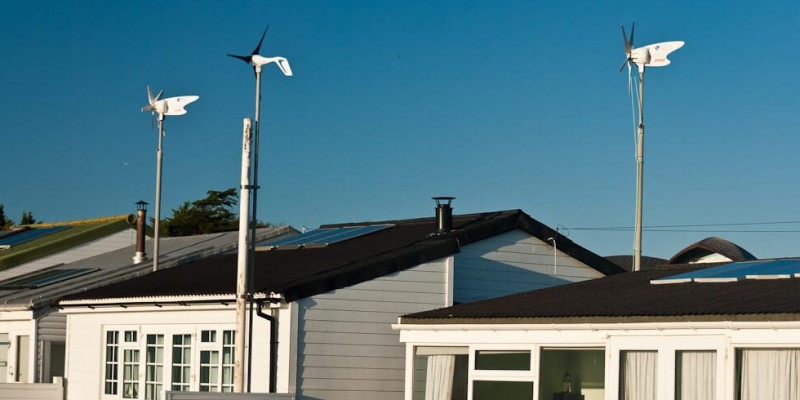 Two statements have a high probability of being true: (1) Electric prices will increase more quickly than the rate of inflation for several years, and (2) Small wind energy systems require a substantial investment of money and effort. So, is a home wind turbine right for me? If I want to install one, what do I need to do beforehand so I don't waste my money and time? This blog will answer your questions. After reading this, I'm sure you'll be able to make your own choice.
Two statements have a high probability of being true: (1) Electric prices will increase more quickly than the rate of inflation for several years, and (2) Small wind energy systems require a substantial investment of money and effort. So, is a home wind turbine right for me? If I want to install one, what do I need to do beforehand so I don't waste my money and time? This blog will answer your questions. After reading this, I'm sure you'll be able to make your own choice. Wind is an intermittent source of energy, meaning that wind turbines only produce electricity when the wind is blowing at sufficient speeds. Therefore, a wind farm operator cannot guarantee how much electricity, if any, the facility will generate at a particular time. For this reason, New York State has implemented a number of system and operating practices to accommodate the growth of wind energy, including one of the nation’s first centralized wind forecasting systems, which provides power grid operators with an advance estimate of how much wind energy to expect.
Wind is an intermittent source of energy, meaning that wind turbines only produce electricity when the wind is blowing at sufficient speeds. Therefore, a wind farm operator cannot guarantee how much electricity, if any, the facility will generate at a particular time. For this reason, New York State has implemented a number of system and operating practices to accommodate the growth of wind energy, including one of the nation’s first centralized wind forecasting systems, which provides power grid operators with an advance estimate of how much wind energy to expect.
Can I use wind energy to power my home?  More people across the country are asking this question as they look for a hedge against increasing electricity rates and a way to harvest their local wind resources. Although wind turbines large enough to provide a significant portion of the electricity needed by the average U.S. home generally require 1 acre of property or more, approximately 19.3% of the U.S. population lives in rural areas and may own land parcels large enough to accommodate a wind energy system.
More people across the country are asking this question as they look for a hedge against increasing electricity rates and a way to harvest their local wind resources. Although wind turbines large enough to provide a significant portion of the electricity needed by the average U.S. home generally require 1 acre of property or more, approximately 19.3% of the U.S. population lives in rural areas and may own land parcels large enough to accommodate a wind energy system.
 More people across the country are asking this question as they look for a hedge against increasing electricity rates and a way to harvest their local wind resources. Although wind turbines large enough to provide a significant portion of the electricity needed by the average U.S. home generally require 1 acre of property or more, approximately 19.3% of the U.S. population lives in rural areas and may own land parcels large enough to accommodate a wind energy system.
More people across the country are asking this question as they look for a hedge against increasing electricity rates and a way to harvest their local wind resources. Although wind turbines large enough to provide a significant portion of the electricity needed by the average U.S. home generally require 1 acre of property or more, approximately 19.3% of the U.S. population lives in rural areas and may own land parcels large enough to accommodate a wind energy system.
Wind turbines generate electrical power in the same way as all other generation technologies. The only difference is in the source of the mechanical power supplied to the electrical generator: wind, rather than a diesel engine or steam turbine, provides the energy. Blades capture energy in the wind and turn the turbines. Control mechanisms point the blades into the wind (yaw control) and, on large wind turbines, adjust the pitch of the blades (blade angle) as wind speeds change. Typically, a gearbox connects the shaft from the blades (rotor) to the electrical generator.
Offshore wind currently accounts for a small amount of the total installed wind power capacity in the world approximately 1%. The development of offshore wind has mainly been in northern European counties, 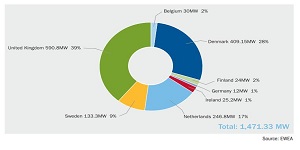 around the North Sea and the Baltic Sea, where about 20 projects have been implemented. At the end of 2008, 1,471 MW of capacity was located offshore. Nine countries have operating offshore wind farms: Belgium, Denmark, Finland, Germany, Ireland, Italy, the Netherlands, Sweden and the UK, as shown in Figure 1.28 and Table 1.3. In 2007, the Swedish offshore wind farm, Lillgrunden was installed with a rated capacity of 110 MW. Most of the capacity has been installed in relatively shallow waters (under 20m water depth), no more than 20 km from the coast, in order to minimise the extra costs of foundations and sea cables.
around the North Sea and the Baltic Sea, where about 20 projects have been implemented. At the end of 2008, 1,471 MW of capacity was located offshore. Nine countries have operating offshore wind farms: Belgium, Denmark, Finland, Germany, Ireland, Italy, the Netherlands, Sweden and the UK, as shown in Figure 1.28 and Table 1.3. In 2007, the Swedish offshore wind farm, Lillgrunden was installed with a rated capacity of 110 MW. Most of the capacity has been installed in relatively shallow waters (under 20m water depth), no more than 20 km from the coast, in order to minimise the extra costs of foundations and sea cables.
 around the North Sea and the Baltic Sea, where about 20 projects have been implemented. At the end of 2008, 1,471 MW of capacity was located offshore. Nine countries have operating offshore wind farms: Belgium, Denmark, Finland, Germany, Ireland, Italy, the Netherlands, Sweden and the UK, as shown in Figure 1.28 and Table 1.3. In 2007, the Swedish offshore wind farm, Lillgrunden was installed with a rated capacity of 110 MW. Most of the capacity has been installed in relatively shallow waters (under 20m water depth), no more than 20 km from the coast, in order to minimise the extra costs of foundations and sea cables.
around the North Sea and the Baltic Sea, where about 20 projects have been implemented. At the end of 2008, 1,471 MW of capacity was located offshore. Nine countries have operating offshore wind farms: Belgium, Denmark, Finland, Germany, Ireland, Italy, the Netherlands, Sweden and the UK, as shown in Figure 1.28 and Table 1.3. In 2007, the Swedish offshore wind farm, Lillgrunden was installed with a rated capacity of 110 MW. Most of the capacity has been installed in relatively shallow waters (under 20m water depth), no more than 20 km from the coast, in order to minimise the extra costs of foundations and sea cables. The cost of onshore wind energy can vary depending on factors such as location, turbine size, project scale,
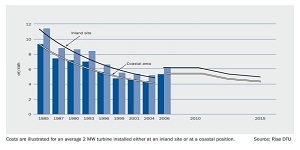
and local regulatory conditions. However, in recent years, the cost of onshore wind power has generally decreased due to technological advancements, economies of scale, and increasing market competition.
Below, we present the cost per kWh of onshore wind energy. We will also make a distinction between the unit costs at land and those at the sea, which turn out to be rather different. The total cost per kWh produced (unit cost) is calculated by discounting and levelising investment and O&M costs over the lifetime of the turbine, and then dividing them by the annual electricity production.
If wind generation becomes more popular and replaces some part of the electricity currently supplied by gas and coal, total CO2 emissions due to electricity generation will decrease. 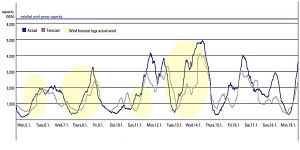 In a report for the U.K. Energy Research Council (and partly funded by the Carbon Trust—a U.K. government-funded organization dedicated to promoting reduced emissions of carbon dioxide), Gross et al. estimate that a 1% increase in wind penetration results in a 0.5% reduction of CO2 emissions. If this is correct, moving from 0% penetration to 20% penetration would reduce CO2 emissions by about 10%.
In a report for the U.K. Energy Research Council (and partly funded by the Carbon Trust—a U.K. government-funded organization dedicated to promoting reduced emissions of carbon dioxide), Gross et al. estimate that a 1% increase in wind penetration results in a 0.5% reduction of CO2 emissions. If this is correct, moving from 0% penetration to 20% penetration would reduce CO2 emissions by about 10%.
 In a report for the U.K. Energy Research Council (and partly funded by the Carbon Trust—a U.K. government-funded organization dedicated to promoting reduced emissions of carbon dioxide), Gross et al. estimate that a 1% increase in wind penetration results in a 0.5% reduction of CO2 emissions. If this is correct, moving from 0% penetration to 20% penetration would reduce CO2 emissions by about 10%.
In a report for the U.K. Energy Research Council (and partly funded by the Carbon Trust—a U.K. government-funded organization dedicated to promoting reduced emissions of carbon dioxide), Gross et al. estimate that a 1% increase in wind penetration results in a 0.5% reduction of CO2 emissions. If this is correct, moving from 0% penetration to 20% penetration would reduce CO2 emissions by about 10%.
The huge expected increase in global onshore wind installed capacity over the coming decades inevitably raises technical questions regarding how and where to accommodate the new wind facilities. 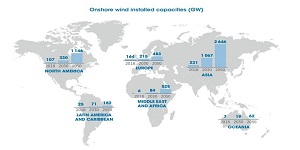 Other than the presence of the primary wind source, fundamental aspects to be considered are the availability of land, the need for additional infrastructure and power system flexibility measures, adequate manufacturing facilities and transport needs to allow the development and operation of the new wind farms. Rising concerns about climate change, the health effects of air pollution, energy security and energy access, along with volatile oil prices in recent decades, have led to the need to produce and use alternative, low-carbon technology options such as renewables.
Other than the presence of the primary wind source, fundamental aspects to be considered are the availability of land, the need for additional infrastructure and power system flexibility measures, adequate manufacturing facilities and transport needs to allow the development and operation of the new wind farms. Rising concerns about climate change, the health effects of air pollution, energy security and energy access, along with volatile oil prices in recent decades, have led to the need to produce and use alternative, low-carbon technology options such as renewables.
 Other than the presence of the primary wind source, fundamental aspects to be considered are the availability of land, the need for additional infrastructure and power system flexibility measures, adequate manufacturing facilities and transport needs to allow the development and operation of the new wind farms. Rising concerns about climate change, the health effects of air pollution, energy security and energy access, along with volatile oil prices in recent decades, have led to the need to produce and use alternative, low-carbon technology options such as renewables.
Other than the presence of the primary wind source, fundamental aspects to be considered are the availability of land, the need for additional infrastructure and power system flexibility measures, adequate manufacturing facilities and transport needs to allow the development and operation of the new wind farms. Rising concerns about climate change, the health effects of air pollution, energy security and energy access, along with volatile oil prices in recent decades, have led to the need to produce and use alternative, low-carbon technology options such as renewables.
With respect to wind turbine noise, the one adverse impact that is supported by epidemiological data is an association between wind farms and annoyance.  However, the rates of self-reported annoyance do not appear to correlate strongly, if at all, with quantitative assessments of the sound levels experienced by the population. Instead they appear more strongly influenced by other factors, including the nature and properties of the landscape, the personal views of the residents toward wind power, and whether the residents are personally benefiting from the operation of the facility.
However, the rates of self-reported annoyance do not appear to correlate strongly, if at all, with quantitative assessments of the sound levels experienced by the population. Instead they appear more strongly influenced by other factors, including the nature and properties of the landscape, the personal views of the residents toward wind power, and whether the residents are personally benefiting from the operation of the facility.
 However, the rates of self-reported annoyance do not appear to correlate strongly, if at all, with quantitative assessments of the sound levels experienced by the population. Instead they appear more strongly influenced by other factors, including the nature and properties of the landscape, the personal views of the residents toward wind power, and whether the residents are personally benefiting from the operation of the facility.
However, the rates of self-reported annoyance do not appear to correlate strongly, if at all, with quantitative assessments of the sound levels experienced by the population. Instead they appear more strongly influenced by other factors, including the nature and properties of the landscape, the personal views of the residents toward wind power, and whether the residents are personally benefiting from the operation of the facility.
Commercial wind farms have been in existence for over 35 years. The world’s first commercial scale wind turbine (1 MW) was built and connected to the grid in Vermont in 1941. I n the 1970’s NASA began research into large-scale commercial turbines and installed 13 experimental units in Ohio. In 1980, the world’s first commercial wind farm, consisting of 20 turbines was installed in New Hampshire. Today, every state in the United States has an operational wind energy project, a wind-related manufacturing facility, or both.As of the end of 2015, world wind turbine capacity is approximately 428 GW (428 billion watts). In the U.S. and Puerto Rico alone, there was nearly 66 GW of wind capacity generated by roughly 46,000 operational turbines in 2014. During the last decade there has been a more than seven fold increase in wind power generation in the U.S.
n the 1970’s NASA began research into large-scale commercial turbines and installed 13 experimental units in Ohio. In 1980, the world’s first commercial wind farm, consisting of 20 turbines was installed in New Hampshire. Today, every state in the United States has an operational wind energy project, a wind-related manufacturing facility, or both.As of the end of 2015, world wind turbine capacity is approximately 428 GW (428 billion watts). In the U.S. and Puerto Rico alone, there was nearly 66 GW of wind capacity generated by roughly 46,000 operational turbines in 2014. During the last decade there has been a more than seven fold increase in wind power generation in the U.S.
 n the 1970’s NASA began research into large-scale commercial turbines and installed 13 experimental units in Ohio. In 1980, the world’s first commercial wind farm, consisting of 20 turbines was installed in New Hampshire. Today, every state in the United States has an operational wind energy project, a wind-related manufacturing facility, or both.As of the end of 2015, world wind turbine capacity is approximately 428 GW (428 billion watts). In the U.S. and Puerto Rico alone, there was nearly 66 GW of wind capacity generated by roughly 46,000 operational turbines in 2014. During the last decade there has been a more than seven fold increase in wind power generation in the U.S.
n the 1970’s NASA began research into large-scale commercial turbines and installed 13 experimental units in Ohio. In 1980, the world’s first commercial wind farm, consisting of 20 turbines was installed in New Hampshire. Today, every state in the United States has an operational wind energy project, a wind-related manufacturing facility, or both.As of the end of 2015, world wind turbine capacity is approximately 428 GW (428 billion watts). In the U.S. and Puerto Rico alone, there was nearly 66 GW of wind capacity generated by roughly 46,000 operational turbines in 2014. During the last decade there has been a more than seven fold increase in wind power generation in the U.S.
Modern low RPM (Revolutions Per Minute) turbines are very quiet, with sound levels usually below that of typical ambient noise in the home. Wind turbine sounds come from two primary sources, mechanical and aerodynamic.  As with many technologies, there have been substantial improvements over time. Noise reduction often coincides with increases in turbine efficiency, so industry has been particularly motivated to make these improvements. Measured sound levels from wind turbines depend on several factors, including weather conditions, the number of turbines, turbine layout, local topography, the particular turbine being used, distance between the turbines and the listener, local vegetation, and the time of day and time of year. As noted above wind power and thus wind turbine noise tends to be greater at night and in the winter.
As with many technologies, there have been substantial improvements over time. Noise reduction often coincides with increases in turbine efficiency, so industry has been particularly motivated to make these improvements. Measured sound levels from wind turbines depend on several factors, including weather conditions, the number of turbines, turbine layout, local topography, the particular turbine being used, distance between the turbines and the listener, local vegetation, and the time of day and time of year. As noted above wind power and thus wind turbine noise tends to be greater at night and in the winter.
 As with many technologies, there have been substantial improvements over time. Noise reduction often coincides with increases in turbine efficiency, so industry has been particularly motivated to make these improvements. Measured sound levels from wind turbines depend on several factors, including weather conditions, the number of turbines, turbine layout, local topography, the particular turbine being used, distance between the turbines and the listener, local vegetation, and the time of day and time of year. As noted above wind power and thus wind turbine noise tends to be greater at night and in the winter.
As with many technologies, there have been substantial improvements over time. Noise reduction often coincides with increases in turbine efficiency, so industry has been particularly motivated to make these improvements. Measured sound levels from wind turbines depend on several factors, including weather conditions, the number of turbines, turbine layout, local topography, the particular turbine being used, distance between the turbines and the listener, local vegetation, and the time of day and time of year. As noted above wind power and thus wind turbine noise tends to be greater at night and in the winter.
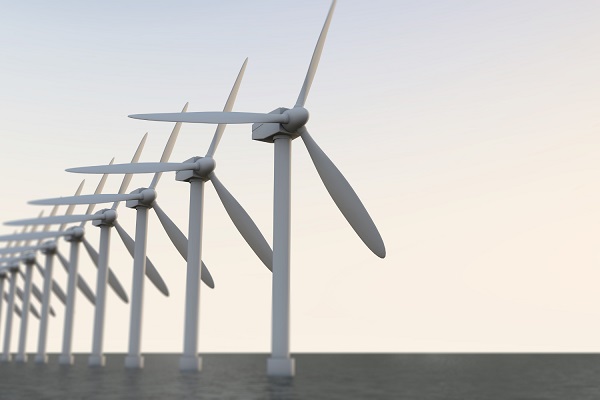
Featured Articles
Is Wind Energy Practical for Me?
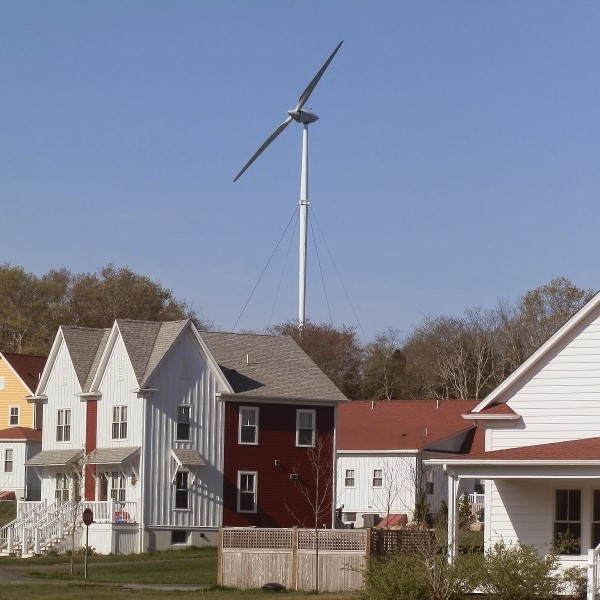 Can I use wind energy to power my home? More people across the country are asking this question as they look for a hedge ...
Can I use wind energy to power my home? More people across the country are asking this question as they look for a hedge ...
 Can I use wind energy to power my home? More people across the country are asking this question as they look for a hedge ...
Can I use wind energy to power my home? More people across the country are asking this question as they look for a hedge ...How do Wind Turbines Work?
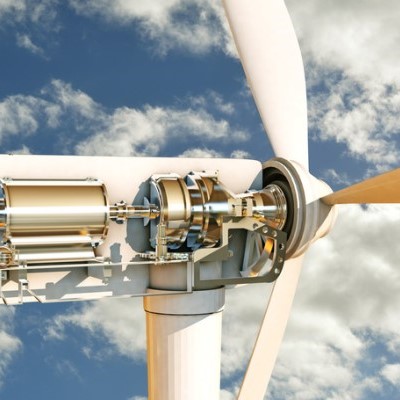 Wind turbines generate electrical power in the same way as all other generation technologies. The only difference is in the ...
Wind turbines generate electrical power in the same way as all other generation technologies. The only difference is in the ...
 Wind turbines generate electrical power in the same way as all other generation technologies. The only difference is in the ...
Wind turbines generate electrical power in the same way as all other generation technologies. The only difference is in the ...Does the Sound of Wind Turbines Affect ...
 With respect to wind turbine noise, the one adverse impact that is supported by epidemiological data is an association between ...
With respect to wind turbine noise, the one adverse impact that is supported by epidemiological data is an association between ...
 With respect to wind turbine noise, the one adverse impact that is supported by epidemiological data is an association between ...
With respect to wind turbine noise, the one adverse impact that is supported by epidemiological data is an association between ...What Sounds Do Turbines Make?
 Modern low RPM (Revolutions Per Minute) turbines are very quiet, with sound levels usually below that of typical ambient noise in ...
Modern low RPM (Revolutions Per Minute) turbines are very quiet, with sound levels usually below that of typical ambient noise in ...
 Modern low RPM (Revolutions Per Minute) turbines are very quiet, with sound levels usually below that of typical ambient noise in ...
Modern low RPM (Revolutions Per Minute) turbines are very quiet, with sound levels usually below that of typical ambient noise in ...How Much Energy Will Wind Turbine ...
 According to the AWEA Small Wind Turbine Performance and Safety Standard, the Rated Annual Energy of a wind turbine for ...
According to the AWEA Small Wind Turbine Performance and Safety Standard, the Rated Annual Energy of a wind turbine for ...
 According to the AWEA Small Wind Turbine Performance and Safety Standard, the Rated Annual Energy of a wind turbine for ...
According to the AWEA Small Wind Turbine Performance and Safety Standard, the Rated Annual Energy of a wind turbine for ...